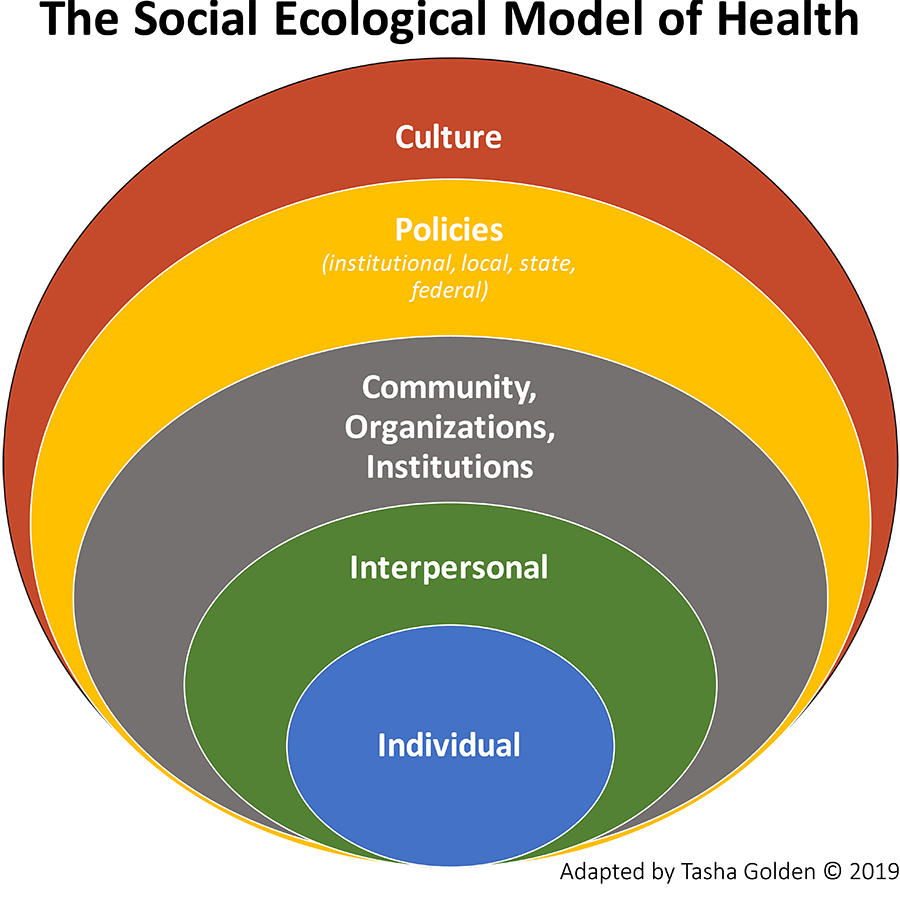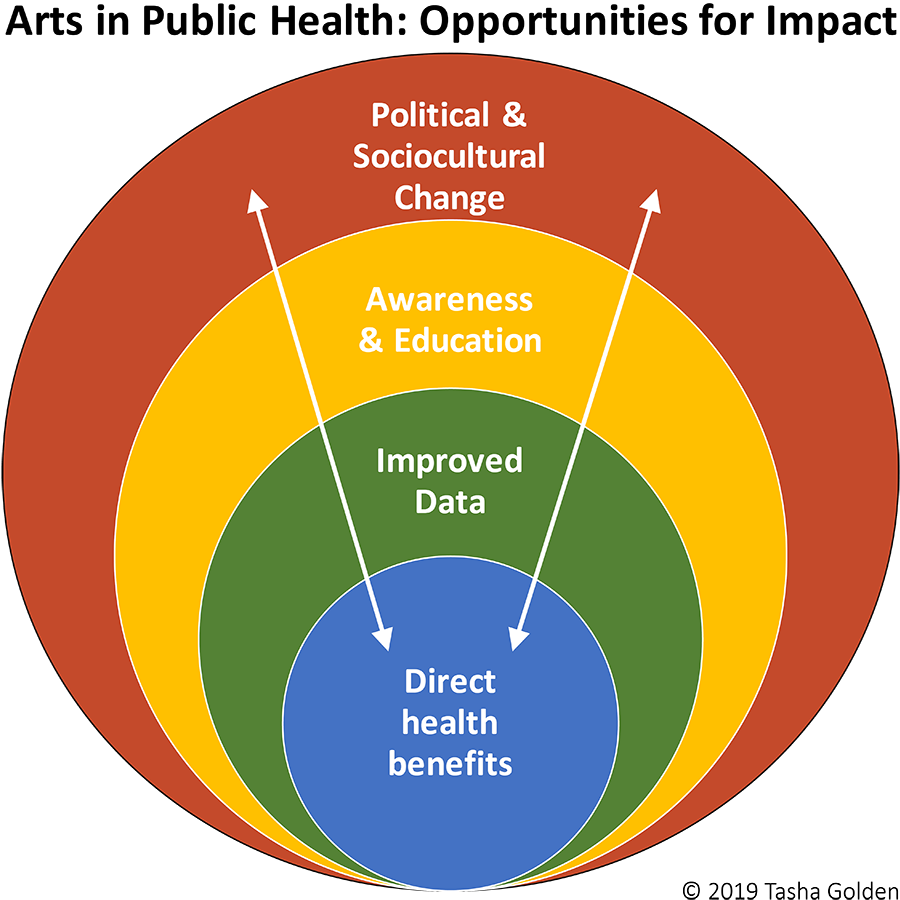The Arts and Health Equity: Four Opportunities for Impact
“We made the world we’re living in and we have to make it over.”
—James Baldwin
In the US, the field of public health is undergoing a paradigmatic shift—moving from a focus on individual health behaviors to a “social ecological” approach. The latter recognizes that individual experiences and choices related to health are often determined by factors beyond the individual, such as environment, policy, or culture. The social ecological model (right) helps visualize this fact by identifying individual health within its broad contexts. The model also helps illuminates why there are such disparities in health outcomes across geographic, racial, gender, and economic differences. These result from disparities in culture, policies, community histories and opportunities, etc.
The recognition of how these social determinants affect our health has led to increased efforts to advance health equity—ensuring that all people have “a fair and just opportunity to be as healthy as possible.” Making change at the outer levels of the social ecological model is no small undertaking. It presents an ideal opportunity to establish new arts+health partnerships, bringing greater creativity, innovation, and inclusion to public health’s efforts. After all, the social determinants of health are the result not of natural, cause-effect imperatives, but of our collective histories, powers, assumptions, hierarchies, perceptions, norms. The constructed nature of our inequitable context means it can be rebuilt. As Baldwin wrote, “we made the world we are living in, and we have to make it over.” Doing so will require collaboration and bold creativity.
A Place to Begin
My hope is to stimulate or expand innovation and action by offering an evolving model for art’s potential health impacts (right). Grounded in my research and practice at the intersection of the arts and public health, this model provides a starting point for conversation and partnership.
In reality, the four broad domains it identifies deeply affect and overlap one another, as noted by the arrows. But visualizing and considering them separately can help arts organizations, programs, funders, and evaluators tackle new angles and opportunities. As with the social ecological model, thinking more intentionally about contexts and multi-level effects can widen the lens for innovation and meaningful change.
Direct Health Benefits
When I mention that I study the impact of the arts on health, most people think immediately of direct health benefits—such as those we might receive from art or music therapy, or from the presence of art in health care settings. Many are also aware of the proven positive impacts of general access to and participation in the arts. For example, attending concerts or visiting museums can increase social connectivity, improve one’s sense of physical and mental well-being, and increase academic achievement and job satisfaction. (Check out GIA’s 2017 lit review, and these varied resources.) As a domain of impact, Direct Health Benefits is a significant and intuitive place to start—but it may just be the beginning.
Improved Data
The arts also provide significant and unique ways to improve what we know about ourselves, our contexts, and one another. It’s not news to most GIA readers that art creates unique spaces and opportunities to speak the otherwise unspeakable. What may be newer is the question of what this phenomenon means for health knowledge, data collection, and the development of effective health responses.
For example, in my work facilitating creative writing workshops with incarcerated girls, the data we receive via girls’ poetry is vastly different from what we receive via health surveys. Participants’ poems offer extensive detail about their needs and difficulties, while also revealing their power and creativity. So two questions I regularly pose are:
- What do researchers and health providers not know about communities and populations, because we’ve limited the forms of data or knowledge that we consider valid?
- How are our limited methods perpetuating the very inequities we’re trying to mitigate?
My most recent study was motivated by these questions. I created and tested arts-based methods for researching young women’s experiences of violence… and compared results to survey data from the same populations. The findings (coming soon) indicate what you’re probably guessing: there’s so much we cannot know about young women and violence if we reflexively prioritize conventional methods like surveys and interviews. Advancing equity requires greater trauma- and cultural responsiveness in our research strategies—which itself requires creative innovation. A takeaway: art can generate opportunity and access for the sharing of vital knowledge. What might this mean for your current and future efforts?
Awareness & Education
We have long understood that art can improve health communications. Stories and compelling visuals are often more memorable and shareable than statistics, and they can increase access, understanding, and cultural relevance. In addition, public artforms like publications, performances, or exhibits create intuitive occasions for press coverage. Earned media can then help disseminate health messages, shift public opinion, or generate political will. And of course, art is recognized as an important means of reducing stigma related to issues such as mental illness, HIV/AIDS, domestic violence, or sexual assault. Stigma reduction is necessary for increasing social connectivity and improving access to health care. The awareness generated by art can also help shift communities’ cultures and systems so that (for example) incidents of domestic violence are decreased.
These benefits make artists and arts organizations ideal partners for public health practitioners who aren’t sure how best to communicate or disseminate information. In addition, artists and arts organizations may realize new impacts by reframing their work to boost public education and awareness. For example, each year we publish anthologies of poems by participants in our detention-based writing workshops—the result of a partnership with international literary publisher Sarabande Books. These books are intended not only for the authors themselves, but for broad public dissemination. The goal is to raise awareness about an underserved and under-heard population, and to shift policies and resources that affect girls’ lives. Might some of your work be similarly (re)framed for new or outside audiences?
Political and Sociocultural Change
Finally, related to awareness and education, artists have historically been at the forefront of social movements—stimulating and sustaining collective action and political will. More broadly, art has the capacity to humanize populations and issues, offering new frames through which to see the “other.” This can create perspective shifts that lead to sociocultural change. Such shifts are critical for persuading voters and legislators about necessary policy changes, and for shifting norms and narratives that perpetuate inequity.
As the field of public health focuses on these goals to advance health equity, it would do well to partner with artists and arts-engaged social movements that have organized and mobilized for change. In addition, artists and arts-related organizations may choose to partner with public health agencies or professionals in order to co-identify cultural narratives, inequitable practices, or local policies that are affecting health. Artists could then consider how their work will help organize, mobilize, re-narrate, or persuade toward established health goals.
Bringing Domains Together
Most arts-based programs, events, CFPs, or organizations aim for one or two of these broad domains, leaving behind ready possibilities for further impacts. For example, many youth arts programs seek to provide direct health benefits (therapeutic, educational), but don’t recognize youths’ art as a source of data, or as potential means of changing the hearts and minds of policymakers. Similarly, photovoice projects often elicit art for data and policy-change purposes, but fail to consider how to optimize direct health benefits. Adding these domains would not require program overhauls, but it would suggest new partnerships, priorities, and modes of outreach. Thinking in multiple domains isn’t about overextending our capacity, but about building networks and stimulating our imaginations.
The complex nature of the social determinants of health can render them difficult to identify, measure, and change. We can’t advance health equity without cross-sector, transdisciplinary work that builds on diverse strengths and multiple ways of knowing. To this work, the arts contribute multiple levels and forms of creativity, inquiry, rigor, and humanization—helping us see the world as it is, and helping us “make it over.”
Tasha Golden, PhD is a public health research consultant whose work is informed by her career in the arts. As frontwoman and songwriter for the critically-acclaimed band Ellery, Golden toured full-time for many years in the US and abroad, and her songs have been in feature films and TV dramas. Now a health researcher and innovator, Dr. Golden develops transdisciplinary, creative partnerships and practices that address community health, health equity, communications, and health education processes. She also leads writing workshops for incarcerated teen women—who are among her greatest teachers. http://www.tashagolden.com


